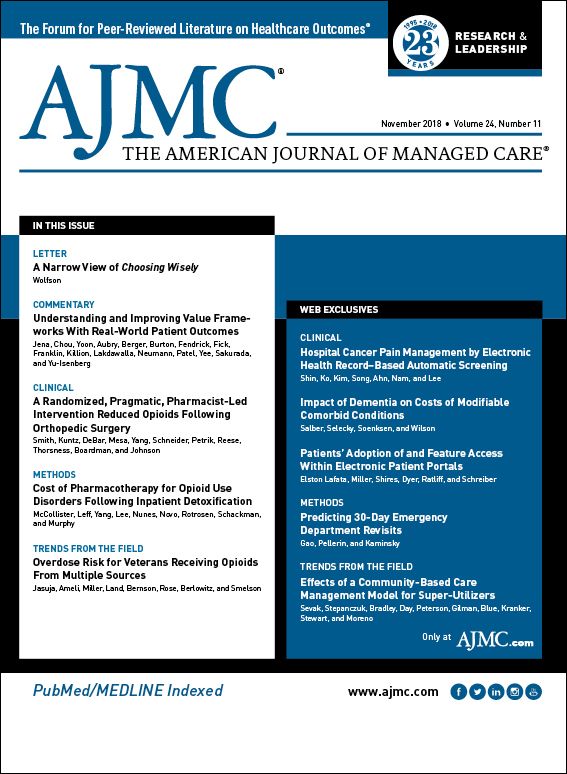- Center on Health Equity and Access
- Clinical
- Health Care Cost
- Health Care Delivery
- Insurance
- Policy
- Technology
- Value-Based Care
A Narrow View of Choosing Wisely
This letter argues that an editorial published in the August 2018 issue provides an unduly limited perspective of the impact of Choosing Wisely.
Am J Manag Care. 2018;24(11):501As a leader of Choosing Wisely, I agree that the decision of more than 80 specialty societies to join a campaign to highlight the prevalence and importance of unnecessary care was a “defining moment,” as stated by the authors of “Levers to Reduce Use of Unnecessary Services: Creating Needed Headroom to Enhance Spending on Evidence-Based Care,” published in the August 2018 issue of The American Journal of Managed Care®.1 However, that editorial provided an unduly limited perspective of the campaign’s impact.
The authors cite just 1 article for their proposition that Choosing Wisely has had a small impact, and it describes an insurer’s review of its claims data for 7 tests or treatments during the campaign’s early stages and in the absence of any intervention designed to reduce utilization. It should surprise no one that this review found limited impact. Indeed, we have never suggested that the recommendations, standing alone, would reshape clinical practice. Rather, we have offered the recommendations, accompanying consumer-facing materials, learning opportunities, and technical assistance to encourage multifaceted interventions.
Over the last 5 years, more than 20 published articles evaluating interventions designed to use Choosing Wisely to reduce unnecessary care have painted a promising picture. For example, the University of Vermont launched a series of utilization reduction projects that employed Choosing Wisely recommendations and achieved results such as a 90% reduction in dual-energy x-ray absorptiometry screening among women 65 years and older who did not present clinical risk factors for osteoporosis.2 Johns Hopkins used Choosing Wisely to achieve a 15% decrease in red blood cell utilization and a 24% decrease in the use of plasma.3 And the University of Utah’s general internal medicine hospitalist service used Choosing Wisely as the basis for a multifaceted intervention that significantly decreased the use of laboratory testing, reducing laboratory costs per patient-day from $138 to $123.4
Recently, a group of 14 health systems operating in 7 regions of the country, funded through a grant program supported by the Robert Wood Johnson Foundation, achieved significant reductions in overuse, particularly in the utilization of antibiotics to treat viral infections in adults. The systems partnered with community organizations and physician groups to design implementation projects and increase awareness among clinicians and their communities as a whole. They used a mix of interventions, including reporting data at the provider and practice levels, small group and individual peer-to-peer education and data presentations, and academic detailing. The results were impressive, with all 14 health systems reducing their use of antibiotics and 12 achieving reductions of 20% or more.
The success of this program demonstrates that the authors’ call to use “multiple synergistic levers” to achieve success is already being heeded and producing positive results. Our campaign has provided critical guidance for clinicians and consumers and demonstrated physicians’ professional commitment to combating unnecessary care. We hope it continues to play a vital role in ensuring appropriate care.Author Affiliations: ABIM Foundation, Philadelphia, PA.
Source of Funding: None.
Author Disclosures: Mr Wolfson is an editorial board member of The American Journal of Managed Care®.
Authorship Information: Concept and design, drafting of the manuscript, and critical revision of the manuscript for important intellectual content.
Address Correspondence to: Daniel B. Wolfson, MHSA, Executive Vice President and COO, ABIM Foundation, 510 Walnut St, Ste 1700, Philadelphia, PA 19106. Email: dwolfson@abim.org.REFERENCES
1. Budros M, Fendrick AM. Levers to reduce use of unnecessary services: creating needed headroom to enhance spending on evidence-based care. Am J Manag Care. 2018;24(8):353-355.
2. Stinnett-Donnelly JM, Stevens PG, Hood VL. Developing a high value care programme from the bottom up: a programme of faculty-resident improvement projects targeting harmful or unnecessary care. BMJ Qual Saf. 2016;25(11):901-908. doi: 10.1136/bmjqs-2015-004546.
3. Hicks CW, Liu J, Yang WW, et al. A comprehensive Choosing Wisely quality improvement initiative reduces unnecessary transfusions in an academic department of surgery. Am J Surg. 2017;214(4):571-576. doi: 10.1016/j.amjsurg.2017.06.020.
4. Yarbrough PM, Kukhareva PV, Horton D, Edholm K, Kawamoto K. Multifaceted intervention including education, rounding checklist implementation, cost feedback, and financial incentives reduces inpatient laboratory costs. J Hosp Med. 2016;11(5):348-354. doi: 10.1002/jhm.2552.


